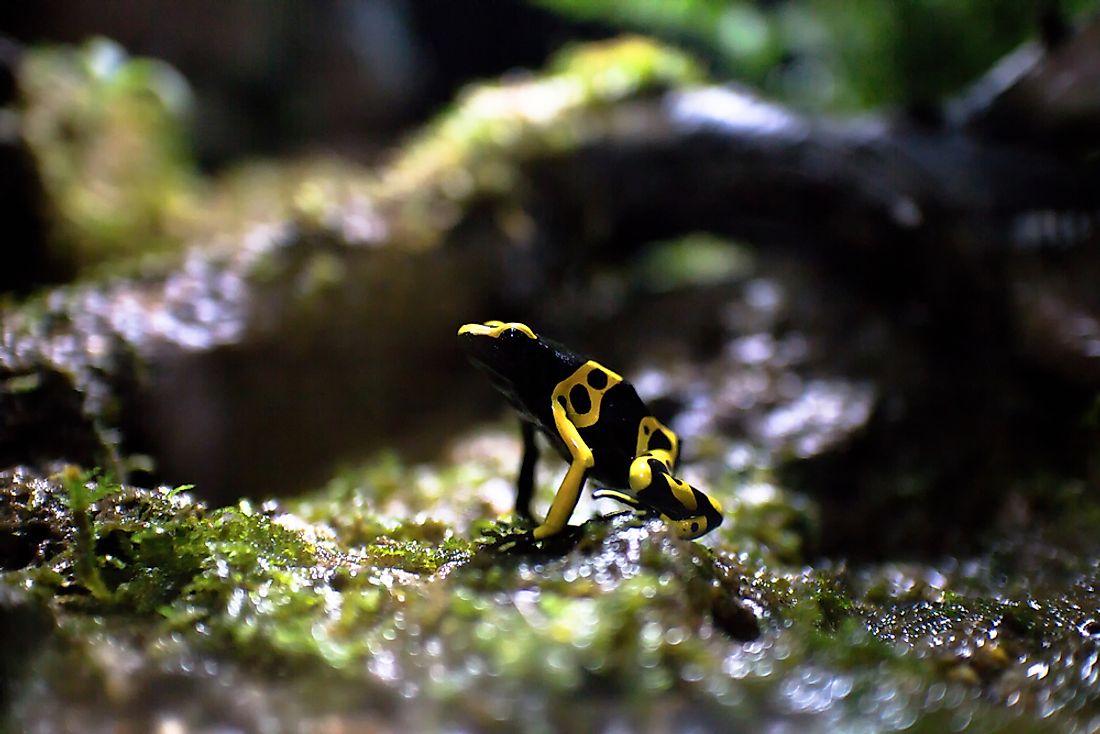Native Amphibians Of Venezuela

Venezuela’s wetlands and rainforests house numerous species of amphibians such as frogs, toads, and salamanders. The country is among the top countries in the world in terms of amphibian diversity. About 363 amphibian species have been recorded in the country, and while some are endemic, others are also present in neighboring countries. The native amphibians of Venezuela are discussed below.
Native Amphibians Of Venezuela
Yellow-Banded Poison Dart Frog (Dendrobates leucomelas)
The yellow-banded poison dart frog (Dendrobates leucomelas) inhabits Venezuela as well as Brazil, Guyana, and eastern Colombia. The species belongs to the Dendrobatidae family, and is often spotted in wet or humid habitats such as wet tree trunks, tree roots, and moist rocks. The species is characterized by yellow skin spotted with black bands which form into spots with maturity and act as a warning to potential predators. The species produces toxic chemicals in the skin that is used against predators. Partially thanks to this, the species can survive for up to seven years in the wild.
The Andes Giant Glass Frog (Espadarana andina)
The Andes giant glass frog (Espadarana andina) is a frog species in the Centrolenidae family native to Venezuela and neighboring Colombia. The species inhabits montane evergreen dry forests and lowland forests near rivers, streams, and creeks. The frog has a green skin with blue spots, with the skin being transparent such that internal organs are visible.
Werner’s Toad (Rhaebo nasicus)
The Werner’s Toad (Rhaebo nasicus) is a toad species in the Bufonidae family native to Venezuela and Guyana. The toad has a color that varies between greyish-brown to reddish-brown. Dark spots, an ochre stripe in the middle and a dark-brown hourglass patch are also sometimes visible. The species has a sharply pointed snout and a spiny upper eyelid. The species inhabits lowland moist forests and cloud forests and breeds along the creeks. It feeds on ants and other arthropods like snails and termites.
Venezuelan Horned Frog (Ceratophrys calcarata)
The Venezuelan Horned Frog (Ceratophrys calcarata) is a frog species in the Ceratophryidae family native to Venezuela and Colombia. The frog inhabits open grasslands, dry savannah, semi-arid regions as well as the occasional freshwater marshes. The frog has green and brown coloration, and it feeds mainly on insects and worms. The species is nocturnal and tends to be rather inactive. The Venezuelan horned frog is listed as least concern although it is threatened by drought, pet trade, and habitat loss.
Other Amphibians
Other native amphibians of Venezuela are Guaramacal Salamander (Bolitoglossa guaramacalensis), Brewer’s Carrying Frog (Stefania breweri), Helena’s Marsupial Frog (Gastrotheca helenae), Nauta Salamander (Bolitoglossa altamazonica), Smooth-Sided Toad (Rhaebo guttatus), and Paramo Robber Frog (Pristimantis paramerus). In the past few years, the amphibian population in Venezuela has been declining due to some factors such as climate change, harvesting for the pet trade, habitat loss and introduction of other species.
Native Amphibians Of Venezuela
| Native Amphibians of Venezuela | Scientific Name |
|---|---|
| Yellow-Banded Poison Dart Frog | Dendrobates leucomelas |
| Andes Giant Glass Frog | Espadarana andina |
| Guaramacal Salamander | Bolitoglossa guaramacalensis |
| Werner's Toad | Rhaebo nasicus |
| Brewer's Carrying Frog | Stefania breweri |
| Venezuelan Horned Frog | Ceratophrys calcarata |
| Helena's Marsupial Frog | Gastrotheca helenae |
| Nauta Salamander | Bolitoglossa altamazonica |
| Smooth-Sided Toad | Rhaebo guttatus |
| Paramo Robber Frog | Pristimantis paramerus |











